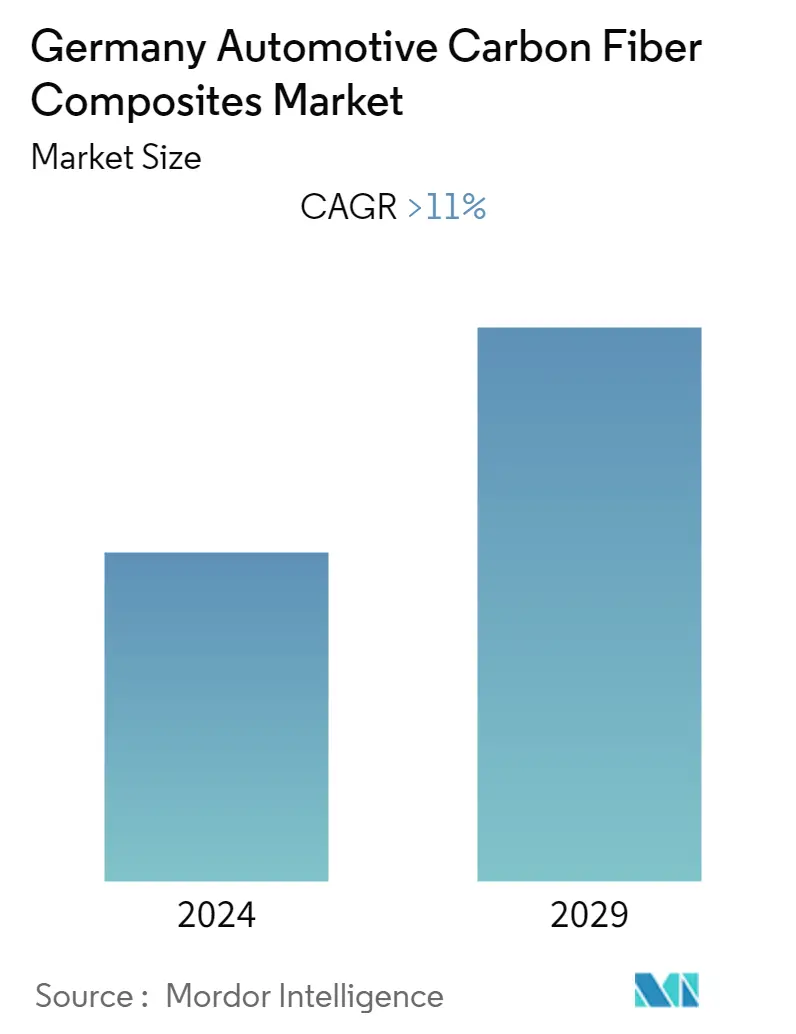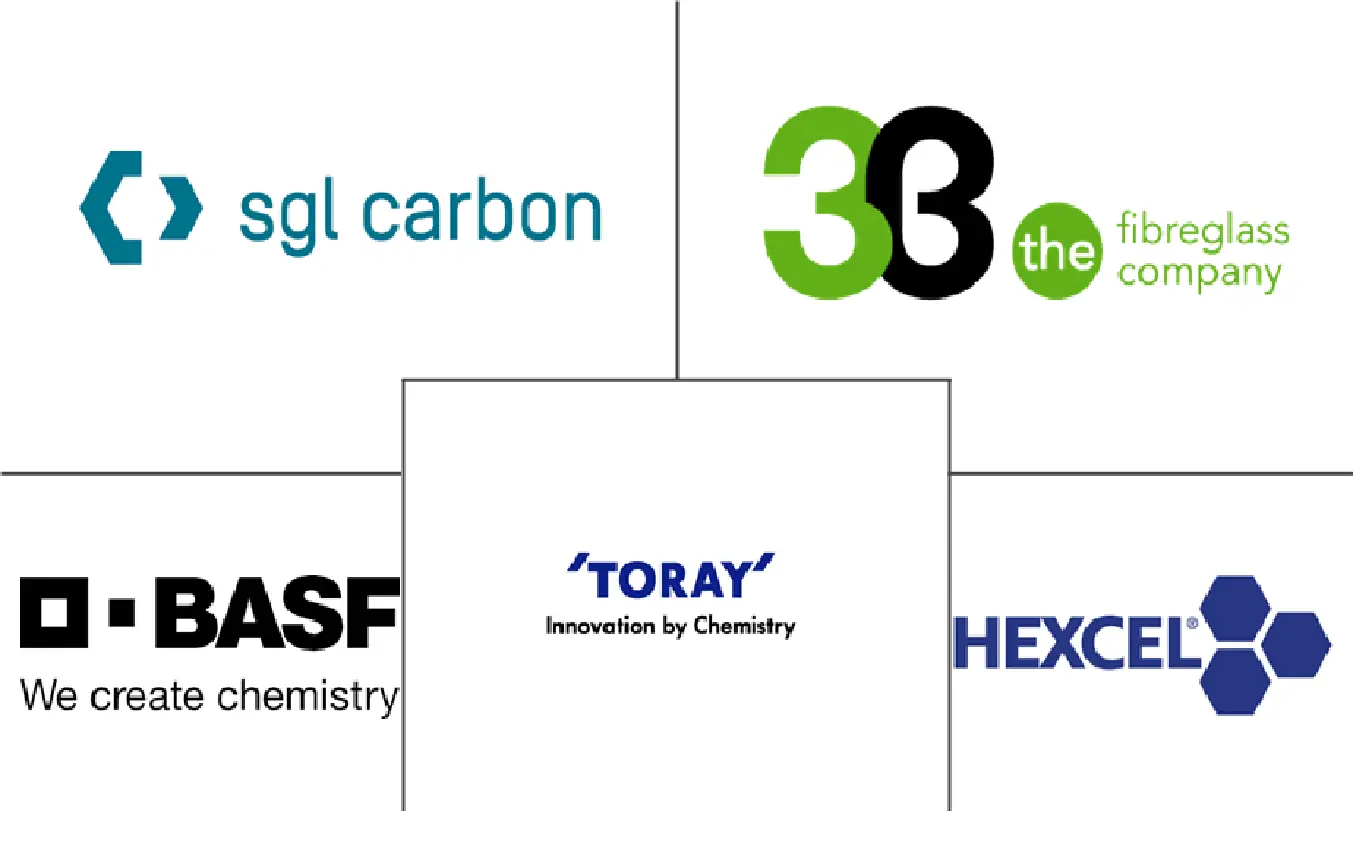Market Size of Germany Automotive Carbon Fiber Composites Industry

| Study Period | 2019 - 2029 |
| Base Year For Estimation | 2023 |
| Forecast Data Period | 2024 - 2029 |
| Historical Data Period | 2019 - 2022 |
| CAGR | 11.00 % |
| Market Concentration | Medium |
Major Players
*Disclaimer: Major Players sorted in no particular order |
Germany Automotive Carbon Fiber Composites Market Analysis
The Germany automotive carbon fiber composites market is expected to grow at a CAGR of over 11% during the forecasted period (2020 - 2025)
- The German automotive industry is one of the largest, with a turnover of over EUR 435.3 billion in 2019. The export value was EUR 217.8 billion, Europe remains the primary market for these export vehicles. Other leading importers of German manufactured vehicles are North and South America. Volkswagen group topped a ranking of the leading manufacturer based on global sales, with almost 11 million units sold worldwide in 2019. In 2019 3.6 million passenger cars were sold in Germany, which was a slight year on the increase from 2018.
- Carbon fiber composites have superior modulus and strength, high impact resistance, and many other advantages like ease of recyclability, corrosion resistance, and processability. These carbon fiber composites have been increasingly used in the automotive industry to meet the increasing tightened corporate average fuel efficiency standards.
- Car manufacturers are forced to reduce dependence on diesel technology due to recent Volkswagen diesel-gate scandal, and they are focusing on electric vehicles. With adaptation of Kyoto Protocol at COP3, the automobile manufacturers are looking for alternate lightweight materials and carbon fiber composites have proven to be that alternative.
- The new energy efficiency goal of Germany is built on previous requirement of maximum 95g CO2/KM of emissions for newly registered LDVs in 2020 which corresponds to 4.1 L/100 Km for gasoline-powered vehicles and 3.6 L/100Km for diesel vehicles (WLTC Test).The European union target for CO2 emission reduction by 2030, 37.5% for cars and 31% for light commercial vehicles. German government has also planned to decarbonise all the sectors by 2050 to eliminate fossil fuel usage which will have positive impact on this market.
Germany Automotive Carbon Fiber Composites Industry Segmentation
The Germany automotive carbon fiber composites market report contains the latest trends and technological developments in the market and demand by application type, production type, and share of major players in the market.
| By Production Type | |
| Hand Layup | |
| Resin Transfer Molding | |
| Vacuum Infusion Processing | |
| Injection Molding | |
| Compression Molding |
| By Application | |
| Structural Assembly | |
| Power train Component | |
| Interior | |
| Exterior | |
| Others |
Germany Automotive Carbon Fiber Composites Market Size Summary
The Germany automotive carbon fiber composites market is poised for significant growth, driven by the country's robust automotive industry and stringent environmental regulations. As one of the largest automotive markets globally, Germany is at the forefront of adopting advanced materials like carbon fiber composites to enhance vehicle performance and meet emission standards. These composites offer superior strength, lightweight properties, and recyclability, making them ideal for luxury and high-performance vehicles. The shift towards electric vehicles and the need to reduce carbon emissions have further accelerated the demand for lightweight materials, positioning carbon fiber composites as a key solution for automotive manufacturers. Despite the high cost of these materials, ongoing technological advancements and increased R&D investments are expected to drive down prices and expand their application in mainstream vehicles.
The market landscape is characterized by intense competition among major players such as SGL Carbon, Toray, and Hexcel Corporation, who are actively pursuing strategies like mergers, acquisitions, and capacity expansions to strengthen their market position. The use of carbon fiber composites is anticipated to grow, particularly in response to stringent EU and US fuel efficiency standards, which mandate significant reductions in vehicle emissions. Additionally, the integration of 3-D printing technology is expected to streamline production processes, further enhancing the feasibility of carbon fiber composites for broader automotive applications. While challenges such as global economic fluctuations and competition from cheaper alternatives, particularly from China, pose risks, the market is expected to experience robust growth during the forecast period, driven by the increasing demand for fuel-efficient and high-performance vehicles.
Germany Automotive Carbon Fiber Composites Market Size - Table of Contents
-
1. MARKET DYNAMICS
-
1.1 Market Drivers
-
1.2 Market Restraints
-
1.3 Porters Five Forces Analysis
-
1.3.1 Threat of New Entrants
-
1.3.2 Bargaining Power of Buyers/Consumers
-
1.3.3 Bargaining Power of Suppliers
-
1.3.4 Threat of Substitute Products
-
1.3.5 Intensity of Competitive Rivalry
-
-
-
2. MARKET SEGMENTATION
-
2.1 By Production Type
-
2.1.1 Hand Layup
-
2.1.2 Resin Transfer Molding
-
2.1.3 Vacuum Infusion Processing
-
2.1.4 Injection Molding
-
2.1.5 Compression Molding
-
-
2.2 By Application
-
2.2.1 Structural Assembly
-
2.2.2 Power train Component
-
2.2.3 Interior
-
2.2.4 Exterior
-
2.2.5 Others
-
-
Germany Automotive Carbon Fiber Composites Market Size FAQs
What is the current Germany Automotive Carbon Fiber Composites Market size?
The Germany Automotive Carbon Fiber Composites Market is projected to register a CAGR of greater than 11% during the forecast period (2024-2029)
Who are the key players in Germany Automotive Carbon Fiber Composites Market?
SGL Carbon, 3B FiberGlass, BASF, Toray Industries Inc. and Hexcel Corporation are the major companies operating in the Germany Automotive Carbon Fiber Composites Market.

